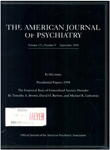Structural abnormalities in deficit and nondeficit schizophrenia
Abstract
OBJECTIVE: Previous studies have suggested the involvement of the frontal and parietal cortices and thalamus in a neural circuit underlying the production of primary enduring negative or deficit symptoms of schizophrenia. The purpose of this study was to examine whether structural changes in the proposed circuit are associated with the production of deficit symptoms. METHOD: Magnetic resonance imaging was used to measure the volume of selected circuit brain regions (i.e., the prefrontal region and caudate) and noncircuit brain regions (i.e., the amygdala/hippocampus complex) in 17 deficit and 24 nondeficit schizophrenic outpatients and 30 normal comparison subjects. RESULTS: Right and left total prefrontal volumes discriminated deficit from nondeficit patients, with prefrontal volumes being smaller in nondeficit patients. There were no differences between the two schizophrenic subgroups in left caudate or right and left amygdala/hippocampus complex volumes. The right caudate was larger in deficit patients, but the difference between the two schizophrenic subgroups was not significant. There were no differences between deficit and normal subjects on any prefrontal region measure. Nondeficit patients had smaller total right and left prefrontal volumes than normal subjects. Both schizophrenic subgroups had larger left caudate volumes and smaller right and left amygdala/hippocampus complex volumes than the normal subjects. There was a trend for deficit patients to have larger right caudate volumes. CONCLUSIONS: These results suggest that structural changes in the prefrontal region are not responsible for deficit symptoms. The caudate, particularly the right caudate, may be associated with the production of these symptoms.
Access content
To read the fulltext, please use one of the options below to sign in or purchase access.- Personal login
- Institutional Login
- Sign in via OpenAthens
- Register for access
-
Please login/register if you wish to pair your device and check access availability.
Not a subscriber?
PsychiatryOnline subscription options offer access to the DSM-5 library, books, journals, CME, and patient resources. This all-in-one virtual library provides psychiatrists and mental health professionals with key resources for diagnosis, treatment, research, and professional development.
Need more help? PsychiatryOnline Customer Service may be reached by emailing [email protected] or by calling 800-368-5777 (in the U.S.) or 703-907-7322 (outside the U.S.).



